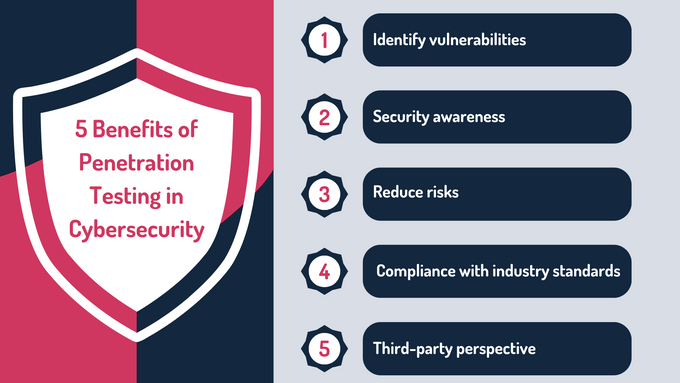What Is Penetration Testing in Cybersecurity: Benefits & Importance
Learn what penetration testing in cybersecurity is and how it helps identify vulnerabilities to protect your systems and data.
Published April 5, 2025.

Penetration testing has emerged as an important component of cybersecurity for businesses aiming to identify and mitigate vulnerabilities. As cyber threats become increasingly sophisticated, organizations need to go beyond standard defenses and adopt proactive testing methods.
In 2023, there were more than 3,000 data breaches in the US alone, affecting more than 350 million people worldwide. As the trends continue, we're seeing year-over-year increases in cyber threats affecting businesses and professional services.
Penetration testing, or "pentesting," mimics real-world cyberattacks, allowing companies to uncover weaknesses in their systems before malicious actors exploit them.
» Get expert penetration testing services tailored for both startups and enterprises
What Is Penetration Testing and How Does it Differ From Vulnerability Assessments?
Penetration testing and vulnerability assessments are both crucial parts of a cybersecurity strategy, each with distinct roles:
| | Vulnerability Scanning | Penetration Testing |
|---|---|---|
| Method | Uses automated tools to scan assets such as networks and applications for known weaknesses. | Involves cybersecurity professionals simulating real-world attacks to exploit identified vulnerabilities. |
| Output | Provides a surface-level report that highlights potential gaps but doesn't explore exploitability. | Provides a deeper, customized analysis of an organization's defenses. |
| Frequency | Generally conducted more frequently and is more cost-effective than penetration testing. | Usually conducted twice a year or after significant changes to systems, offering a proactive, in-depth approach. |
» Did you know? The cloud might not be safe anymore
Industries That Benefit Most From Regular Penetration Testing
Industries with rapid software development cycles, such as software as a service (SaaS) and platform as a service (PaaS) companies, benefit significantly from regular penetration testing. Organizations that develop web applications, APIs, and mobile applications are prime targets for cyberattacks, making it essential to fix security weaknesses early.
In these sectors, penetration testing is a crucial part of a secure development lifecycle (SDL), helping development teams address vulnerabilities before applications go live. It is also vital in regulated industries like finance, healthcare, and government, where data protection and compliance are paramount.
Regular penetration testing in these fields:
- Secures sensitive data
- Ensures regulatory adherence
- Helps avoid penalties and reputational damage
» Boost your organization's cybersecurity with the CIA triad
Key Threats Uncovered Through Penetration Testing
Penetration testing frequently uncovers vulnerabilities highlighted in the OWASP Top 10 list, which identifies the most critical security risks facing applications today. Out of these ten, some of the most commonly identified issues include:
- Cross-site scripting (XSS): This vulnerability enables attackers to inject malicious scripts into web pages, allowing data theft, session hijacking, and unauthorized actions within a user's session.
- Server-side request forgery (SSRF): SSRF exploits weaknesses that allow attackers to force a server to make requests on their behalf, often accessing internal resources and exposing sensitive information.
- Broken access control: This occurs when an application fails to enforce restrictions on user permissions and can lead to data breaches and privilege escalation, giving attackers unauthorized access to sensitive information.
» Understand the disasters you can avoid by tackling cybersecurity on time
Consequences of Ignored Vulnerabilities
Ignoring identified vulnerabilities can lead to significant financial losses, operational disruptions, and potential legal penalties, especially in regulated sectors like healthcare and finance.
Reputational risk heightens the stakes for high-profile brands. A security breach can erode customer trust, resulting in client loss and damaging long-term loyalty. Such incidents often attract negative media coverage, impacting market perception, stock value, and partnerships, emphasizing the need to proactively address vulnerabilities before exploitation occurs.
5 Benefits of Penetration Testing in Cybersecurity
1. Identify Vulnerabilities Proactively
Penetration testing allows organizations to identify and address vulnerabilities before attackers have a chance to exploit them. This approach minimizes potential damage and maintains a strong security posture.
2. Security Awareness for Development Teams
Pentesting builds greater security awareness among development teams, incorporating security best practices into their workflow. With hands-on experience, team members gain a better understanding of common vulnerabilities, reinforcing secure coding practices in real-world contexts.
3. Reduce Risks and Strengthen Network Defenses
Regular penetration testing reduces an organization's exposure to attacks by identifying and remediating security gaps. This approach strengthens network defenses and enhances the organization's overall resilience against potential cyber threats.
4. Compliance with Industry Standards (GDPR, HIPAA, PCI DSS)
Meeting compliance requirements in regulated industries, such as finance and healthcare, often relies on regular penetration testing. Conducting these tests demonstrates a commitment to data protection and helps organizations adhere to standards like HIPAA and PCI DSS.
» Enhance your security with penetration testing and PCI DSS training
5. Third-Party Perspective for Enhanced Objectivity
Having a third party perform penetration testing offers an unbiased assessment of the organization's security posture. With an external view, organizations can uncover overlooked vulnerabilities and gain a clearer understanding of their defenses from an attacker’s perspective.
» Learn more about the different kinds of penetration tests
Best Practices for Conducting Penetration Tests
To ensure penetration tests yield the most effective results, it's important to adhere to the best practices. Let's take a look at the best practices for penetration testing:
- Comprehensive planning: Define the scope and objectives of the penetration test clearly to ensure all critical assets are evaluated. This helps allocate resources effectively and focus on high-risk areas.
- Engage with qualified professionals: Always make use of experienced cybersecurity experts to conduct penetration tests, as their experience and skills are critical for identifying and exploiting potential vulnerabilities.
- Regular testing cadence: Consider scheduling frequent penetration tests to ensure ongoing security, particularly in highly dynamic industries such as SaaS, finance, or healthcare.
- Detailed reporting and follow-up: Ensure that penetration test reports are thorough and complete, outlining discovered vulnerabilities and providing actionable remediation steps.
- Collaboration between teams: Encourage collaboration between the cybersecurity team and development teams to integrate findings and improve future application security.
For high-risk industries, such as e-commerce, finance, healthcare, and SaaS companies, more frequent penetration testing is often necessary to stay ahead of evolving threats and meet stringent regulatory requirements.
» Learn more: Why penetration testing is important for your business
How GRSee's Penetration Testing Services Stand Out
GRSee offers a tailored approach to penetration testing, starting with an in-depth scoping session to focus on high-risk areas and critical assets. Our expert team uses thorough testing methodologies to simulate real-world attack scenarios, identifying vulnerabilities before they can be exploited.
What sets us apart is our commitment to business logic testing, examining workflows to uncover vulnerabilities that standard tests might miss. This allows us to identify issues like bypassing payment processes or manipulating application behavior. Our proactive approach provides actionable insights, helping organizations strengthen their cybersecurity defenses, mitigate risks, and ensure compliance with industry regulations.
» Contact us to start leveraging the benefits of penetration testing







